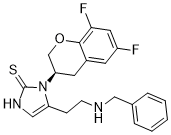Zamicastat (BIA 5-1058)
This product is for research use only, not for human use. We do not sell to patients.

For small sizes, please check our retail website as below: www.invivochem.com
| Size | Price | Stock |
|---|---|---|
| 100mg | $1470 | To Be Confirmed |
| 200mg | $2205 | To Be Confirmed |
| 500mg | $3720 | To Be Confirmed |
Cat #: V28456 CAS #: 1080028-80-3 Purity ≥ 99%
Description: Zamicastat is a potent and selective dopamine β-mono-oxygenase inhibitor.
Top Publications Citing Invivochem Products
Publications Citing InvivoChem Products
Product Promise

- Physicochemical and Storage Information
- Protocol
- Related Biological Data
- Stock Solution Preparation
- Quality Control Documentation
| Molecular Weight (MW) | 401.47 |
|---|---|
| Molecular Formula | C21H21F2N3OS |
| CAS No. | 1080028-80-3 |
| SMILES Code | S=C(N1[C@@H]2CC3=CC(F)=CC(F)=C3OC2)NC=C1CCNCC4=CC=CC=C4 |
| Synonyms | Zamicastat |
| Protocol | In Vitro | Following 4 hours of incubation (5, 10, 20, 50, 80, 100 μM), a significant loss of cell viability is verified with 100 μM Zamicastat (p=0.010) in MDCK-BCRP cells. No significant losses of cell viability are observed after 4 h of incubation for other concentrations in all cell lines. By decreasing the incubation period to 30 min, there is no significant loss of cell viability (p>0.05) at 100 μM in all cell lines. |
|---|---|---|
| In Vivo | Zamicastat (10, 30 and 100 mg/kg/day; oral bolus, 7 days) is tested acutely against salt-induced hypertension in the Dahl SS rat. Zamicastat produces a dose-dependent decrease in blood pressure. 24 h after Zamicastat administration mean systolic blood pressure (SBP) decrease is -12.6±4.1 mm Hg (P=0.0284), -15.2±2.7 mm Hg (P=0.0026) and -19.0±3.7 mm Hg (P=0.0036) for the 10, 30, and 100 mg/kg body weight dose, respectively. Zamicastat administration also produces a significant 24-h average decrease in diastolic blood pressure (DBP) of - 14.6±3.4 mm Hg (P=0.0073) with 10 mg/kg body weight dose, -13.0±4.5 mm Hg (P=0.0347) with 30 mg/kg body weight dose and -15.0±3.1 mm Hg (P=0.0046) with 100 mg/kg body weight dose. Zamicastat administration leads to a decrease in the 24h post-dose mean arterial pressure (MAP) of -13.4±3.8 mm Hg (P=0.0162), -14.0±3.5 mm Hg (P=0.0101) and -20.6±3.7 mm Hg (P=0.0026) for the 10, 30, and 100 mg/kg body weight dose, respectively. There is a small, but significant, effect of Zamicastat on the 24-h mean heart rate (HR) post-dose for all tested doses (10 mg/kg: -19.1±3.2 beats/min, P=0.0019; 30 mg/kg: -13.0±4.5 beats/min, P=0.0347; 100 mg/kg: -21.6±6.6 beats/min, P=0.0235). |
These protocols are for reference only. InvivoChem does not
independently validate these methods.
| Solvent volume to be added | Mass (the weight of a compound) | |||
|---|---|---|---|---|
| Mother liquor concentration | 1mg | 5mg | 10mg | 20mg |
| 1mM | 2.4908 mL | 12.4542 mL | 24.9085 mL | 49.8169 mL |
| 5mM | 0.4982 mL | 2.4908 mL | 4.9817 mL | 9.9634 mL |
| 10mM | 0.2491 mL | 1.2454 mL | 2.4908 mL | 4.9817 mL |
| 20mM | 0.1245 mL | 0.6227 mL | 1.2454 mL | 2.4908 mL |
The molarity calculator equation
Mass(g) = Concentration(mol/L) × Volume(L) × Molecular Weight(g/mol)
Mass
=
Concentration
×
Volume
×
Molecular Weight*
The dilution calculator equation
Concentration(start)
×
Volume(start)
=
Concentration(final)
×
Volume(final)
This equation is commonly abbreviated as: C1 V1 = C2 V2
Concentration(start)
C1
×
Volume(start)
V1
=
Concentration(final)
C2
×
Volume(final)
V2
Step One: Enter information below
Dosage mg/kg
Average weight of animals g
Dosing volume per animal µL
Number of animals
Step Two: Enter the in vivo formulation
%DMSO
+
%
+
%Tween 80
+
%ddH2O
Calculation Results:
Working concentration:
mg/ml;
Method for preparing DMSO master liquid:
mg
drug pre-dissolved in
µL
DMSO(Master liquid concentration
mg/mL)
,Please contact us first if the concentration exceeds the DMSO solubility of the batch of drug.
Method for preparing in vivo formulation:
Take
µL
DMSO master liquid, next add
µL
PEG300, mix and clarify, next add
µL
Tween 80,mix and clarify, next add
µL
ddH2O,mix and clarify.
Note:
- (1) Please be sure that the solution is clear before the addition of next solvent. Dissolution methods like vortex, ultrasound or warming and heat may be used to aid dissolving.
- (2) Be sure to add the solvent(s) in order.




































